Designer French steamer trunks have been collected by both aficionados and novice collectors alike for decades, but what makes them so collectible?
In order to get a better understanding of steamer trunks and their popularity, it is necessary to learn more about their historical context. Following the Industrial Revolution, the invention of steam locomotives and ocean liners from the early to mid-19th century opened the door for intercontinental travel. This resulted in increased use of large trunks to transport traveler’s belongings.
Originally, steamer trunks had a domed top that would protect fine clothing from the elements. However, with increased travel on large ocean liners and trains, how could locomotives and liners successfully store so many pieces of luggage?
In response, Louis Vuitton established his company in 1854, fashioning high end steamer trunks with an innovative rectangular form.
Surprisingly, the first Louis Vuitton trunks did not use the well-known monogram canvas. Early steamer trunks were made in grey canvas. Beginning in 1872, this changed to red and beige striped canvas, and in 1888, moved to a Damier checkerboard canvas. It was not until after Louis Vuitton’s death that the company began to produce trunks with the signature Louis Vuitton monogrammed pattern.

Damier checkerboard canvas trunk, circa 1895
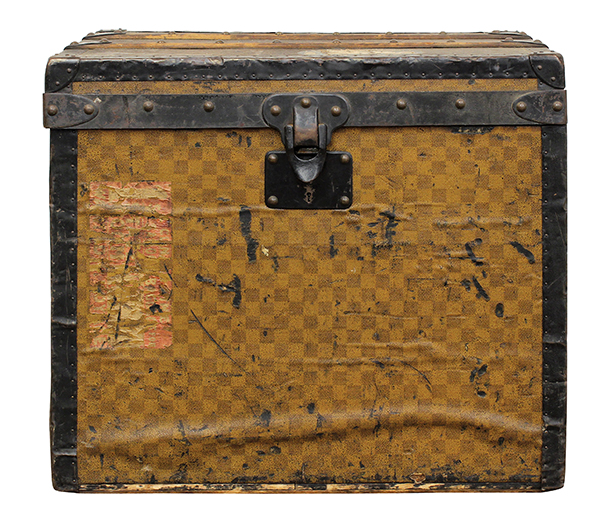
Damier checkerboard canvas trunk, circa 1890
So, how can you successfully find the date of your Louis Vuitton steamer trunk?
The first clue lies with the label found on the interior. Generally, you should pay close attention to the store locations. The newer
the trunk, the more store locations included on the label. Here are several images of labels on a variety of trunks offered at
Clars Auction Gallery.
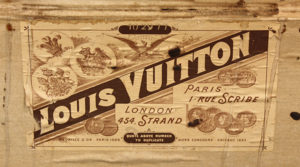
Circa 1895

Circa 1910

Circa 1920
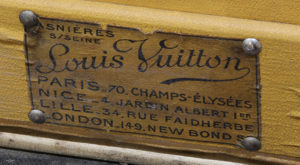
Circa 1920s
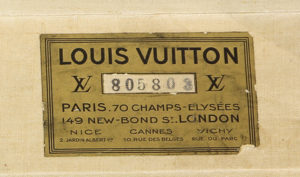
Circa 1960s
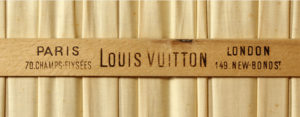 Additionally, you will want to find a stamped or printed serial number. It is also important to take a look at the engravings on the hardware, as well as embroidery and stitching on the interior. Signatures will also appear on other elements, right down to the hangers. As antique Louis Vuitton trunks were not mechanically massed produced, there are many details to look for on a Louis Vuitton trunk.
Additionally, you will want to find a stamped or printed serial number. It is also important to take a look at the engravings on the hardware, as well as embroidery and stitching on the interior. Signatures will also appear on other elements, right down to the hangers. As antique Louis Vuitton trunks were not mechanically massed produced, there are many details to look for on a Louis Vuitton trunk.
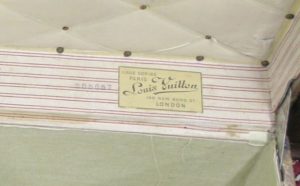 What should I look for when purchasing a Louis Vuitton trunk?
What should I look for when purchasing a Louis Vuitton trunk?
There are several important factors to ask when buying a Louis Vuitton trunk, but it is most important to purchase your trunk from a reputable source. It is imperative is to request additional photographs, and ask the seller questions about the trunk. When in doubt, it is important to send photographs of your trunk and label to a reputable gallery.
Steamer trunks are only one of many forms of luggage produced by Louis Vuitton. Clars Auction Gallery has sold a variety of forms, including a train case, a cabin trunk, a wardrobe, as well as hardcase luggage. A form that is rarer can be more collectible, for example this exceptional vertical Louis Vuitton steamer trunk with basket insert that hammered for $13,000. For further reading, Louis Vuitton has produced a guide titled “Louis Vuitton: 100 Legendary Trunks”, which includes over eight hundred photographs of Louis Vuitton trunks and luggage.
Are there other early 20th century French designers who manufactured steamer trunks?
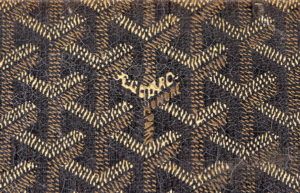 Louis Vuitton was not the only French designer manufacturing steamer trunks at the turn of the 20th century. Another well-known and collectible French designer is Goyard. Goyard was established in 1853, just one year before Louis Vuitton opened his doors. While the company began under the leadership of Francois Goyard, many rectangular steamer trunks, circa 1900, were created under the authority of Edmond Goyard (1860-1937). Goyard is known for its signature chevron canvas. Similar to Louis Vuitton, it is important to take a look at the hardware and interior stitching. As Goyard was also a high end producer, the hardware should be engraved or embossed, and the interior should have the original stitched Goyard strapwork.
Louis Vuitton was not the only French designer manufacturing steamer trunks at the turn of the 20th century. Another well-known and collectible French designer is Goyard. Goyard was established in 1853, just one year before Louis Vuitton opened his doors. While the company began under the leadership of Francois Goyard, many rectangular steamer trunks, circa 1900, were created under the authority of Edmond Goyard (1860-1937). Goyard is known for its signature chevron canvas. Similar to Louis Vuitton, it is important to take a look at the hardware and interior stitching. As Goyard was also a high end producer, the hardware should be engraved or embossed, and the interior should have the original stitched Goyard strapwork.
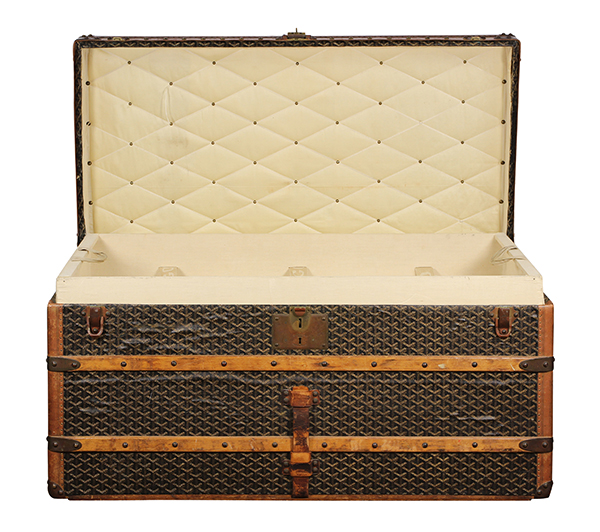
Goyard steamer trunk, circa 1900
Again, if you are unsure if your trunk is an authentic Louis Vuitton or Goyard example, it is advisable to send photographs to a knowledgeable gallery. It is also imperative that you purchase trunks from trustworthy galleries, and ask for additional photographs. A reliable gallery will be happy to address and questions or concerns you may have about a piece.